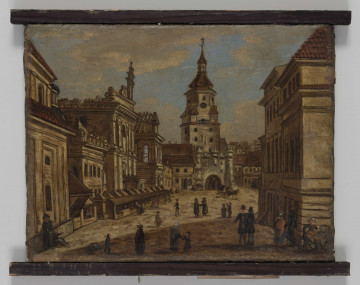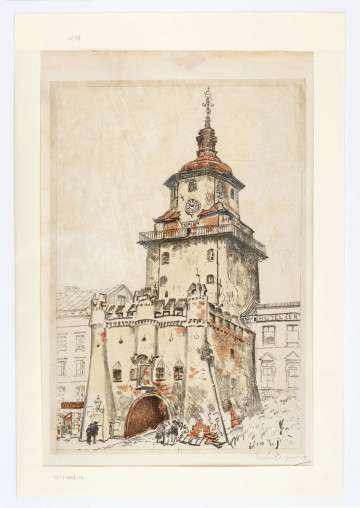
Krakow suburb
circa 1926-1939
National Museum in Lublin
Part of the collection: Landscape
Trachter was one of the most talented painters of Lublin. He received his artistic education at the Academy of Fine Arts in Krakow (1915-1920), developed in Vienna and later in Paris (1925-1929), joining the broad current of École de Paris artists in the 1920s. This artistic biography – typical of the fate of Central and Eastern European artists – also defined the transformations in his painting style, from colourist and post-impressionist lessons towards increasingly simplified, synthetically developed, modern forms.
The painter, travelling on the trail of European artists, joining the artistic colony of Jewish artists in Paris migrating from Eastern Europe, eventually linked his work consistently with Lublin and Kazimierz Dolny.
Brama Krakowska [Kraków Gate] is an insightful, realistic and richly-detailed study of the most important historical artistic object. Painted in the early period of Trachter's work, it allows us to see the historical object before the later conservation measures connected with its post-war ‘re-Gothicisation’. Careful and monumental composition, resulting from the central placement of the building in the painting frame, showing its massiveness, was treated by Trachter to bring out the details but also to emphasise the rank and dominance of the historical gate in the contemporary landscape of Lublin. The image, however, does not exhaust its meanings in the inventorying meticulousness of researching and recording what is. It also shows the subjective conditions of observing an architectural mass seen here and now from a particular point of view. The artistic point of observation set from an oblique angle determines the squat proportions of the object and the beautifully yellow-filled glow of the silhouette of the tower and the shining white lower storey of the foreground. Brama Krakowska is bathed in the summer afternoon sunlight, the clock showing 5.10 p.m. The artist also depicts the hurried movement of figures swarming sketchily in the central square in front of the gate. Trachter depicts the object at a particular time of day, with an observation and rendering of everyday, ongoing life, creating a painterly metaphor for permanence and changeability, echoing the Impressionist lesson that Claude Monet developed when he painted successive versions of Rouen Cathedral.
Marcin Lachowski
Author / creator
Dimensions
cały obiekt: height: 37,5 cm, width: 52 cm
Object type
painting
Technique
oil technique
Material
canvas, oil-based paint
Creation time / dating
Creation / finding place
Owner
The National Museum in Lublin
Identification number
Location / status

circa 1926-1939
National Museum in Lublin

1801 — 1900
National Museum in Lublin

1918 — 1919
National Museum in Lublin
DISCOVER this TOPIC
National Museum in Szczecin
DISCOVER this PATH
Educational path